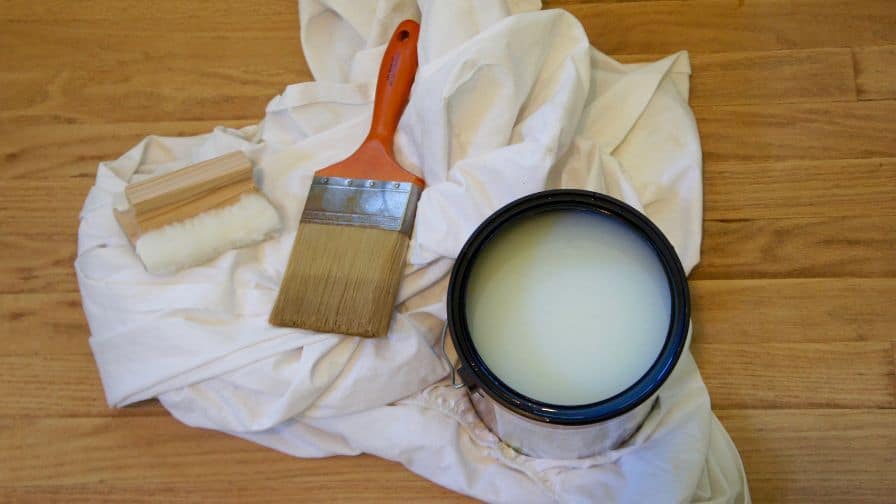
Polyurethane is a versatile product for a variety of purposes. You can use it on wood, metal, plastic, and even fabric.
In this blog post, we will discuss some of the most common applications for polyurethane. We will also give you some tips on how to get the best results when using this product!
What Can You Use Polyurethane On?
Here are things where you can put polyurethane:
- Wood floors
- Kitchen countertops
- Outdoor furniture
- Bathroom fixtures
- Trim and moulding
Polyurethane is a great way to protect your surfaces and give them a nice shine! So next time you’re looking for a new finish, consider it.
What Is Polyurethane And What Are Its Main Uses
Polyurethane consists of two main ingredients: a polyol and an isocyanate. The mixture of these two chemicals reacts to form long chains of molecules, which gives the material its strength and flexibility. It is either hard or soft, depending on the ratio of these two ingredients.
Polyurethane is different from other plastics because it’s a thermoplastic. This means that it can melt and reform multiple times. Plus, you can recycle it.
Polyurethane is a synthetic material that was first created in the 1930s. It’s most common as a flexible, durable, and waterproof material for things like car seats, shoes, and upholstery. Know that it can also make hard plastics like those used in skateboard wheels and computer cases. You can also see it in some paints and adhesives.
How To Use Polyurethane For Different Applications
Polyurethane is one of the most flexible materials on the market. Use it for a variety of applications, from home improvement to automotive repair.
Here are a few tips on how to use polyurethane for different projects:
-For home improvement projects, polyurethane can seal cracks and gaps. It can also protect surfaces from scratches and wear.
-For automotive projects, polyurethane can close and protect car parts from rust and corrosion. It can also fill in dents and scratches.
-For other projects, polyurethane can act as an adhesive or coating. It can also make molds and casts.
With so many uses, it’s no wonder that polyurethane is a popular material for a variety of projects. When using polyurethane, read the label carefully. Some products may require special precautions. With proper use, polyurethane can make any project easier.
Tips For Getting The Best Results With Polyurethane
Polyurethane is one of the most multifaceted finishes for wood floors, but it can get tricky to apply.
Here are tips to get the best results:
-Start by sanding your floor with coarse grit sandpaper to rough up the surface and help the polyurethane adhere.
-Wipe away any dust with a damp cloth before applying the polyurethane.
-Use a brush or roller specifically designed for use with polyurethane to apply the finish in even strokes.
-Work in a well-ventilated area, as fumes from the polyurethane can turn strong.
-Allow the first coat of polyurethane to dry completely before applying a second coat.
With these tips in mind, you’re on your way to getting the perfect polyurethane finish for your wood floors! Take your time and work in small sections so you don’t miss any spots.
Can You Put Polyurethane Over Anything?
Here’s what you need to know before you start your next project.
One of the great things about polyurethane is that it can function on a variety of surfaces. Whether you’re working with wood, metal, or even plastic, polyurethane can provide a durable finish that will protect your project for years to come.
But before you start slathering on the polyurethane, it’s important to understand that not all surfaces are equal. To get the best results, you’ll need to take a few minutes to prepare your surface properly.
When you’re working with wood, for example, you’ll want to make sure that it’s sanded smooth before you apply the polyurethane. Any roughness will magnify once you apply the polyurethane. So it’s important to take care of any imperfections beforehand.
The same is true for metal surfaces. As you’re planning on putting polyurethane on a piece of metal, you’ll want to make sure that it’s clean and free of any dirt or debris. Otherwise, you run the risk of trapping those contaminants beneath the polyurethane. It can lead to a less than perfect finish.
Once you prepare your surface, you’re ready to apply the polyurethane.
So when you’re planning your next project, don’t forget that polyurethane is a great option! Make sure to take the time to prepare your surface properly, and you’ll have a reward for a beautiful and durable finish.



